Undergraduate Research Week Showcases Illinois Undergraduate Students' Research
“The research process includes presentation; that’s something you need to learn how to do!” – Karen Rodriguez'G
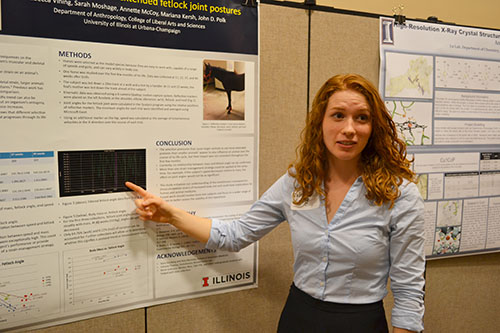 Rebecca Vining presents her research at the Undergraduate Research Symposium (photo courtesy of Kristina Allen).
Rebecca Vining presents her research at the Undergraduate Research Symposium (photo courtesy of Kristina Allen).
May 1, 2018
As part of their research experience, around 1000 undergraduate students from across campus got a chance to hone their presentation skills during Illinois’ fourth annual Undergraduate Research Week on April 15th–21st. Students from a variety of disciplines across campus presented the research they’ve been conducting over this past semester or academic year. While the week featured a variety of events showcasing research or capstone projects in a number of units, its signature event was the Undergraduate Research Symposium, where the students who presented shared that along with learning a great deal about their topic and specific research methodology, their research experience also gave them insight into what they might want to do careerwise.
Touted as a “celebration of student innovation and excellence in research,” Illinois’ Undergraduate Research Week (URW) spotlighted the numerous Illinois undergraduate students involved in research across campus. Hosted by the Office of Undergraduate Research (OUR) and sponsored by the Provost’s Office and the Stevick Foundation, the week featured open houses, poster sessions, expos, presentation of capstone projects, and symposia. The pièce de résistance of the week was the 11th annual Undergraduate Research Symposium (URS) at the Illini Union on Thursday, April 19th.
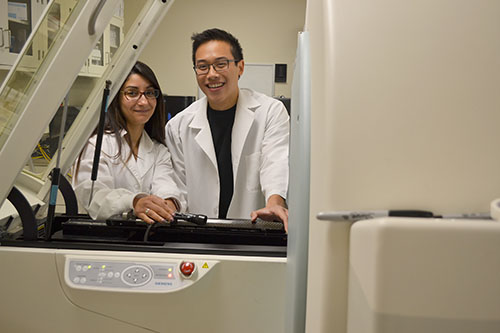 Engineering student Than Huynh (right) with his grad student mentor, Jamila Hedhli, conducting his undergraduate research in Bioengineering Professor Lawrence Dobrucki’s imaging lab.
Engineering student Than Huynh (right) with his grad student mentor, Jamila Hedhli, conducting his undergraduate research in Bioengineering Professor Lawrence Dobrucki’s imaging lab.
While plenty of STEM (Science, Technology, Engineering, and Mathematics) topics were represented, Research Week also highlighted work done in very diverse disciplines across campus, so not just STEM; but education, social sciences, and human behavior; health and wellness; and even traditionally non-STEM areas such as English, performances by Fine and Applied Arts students, and Architecture students’ capstone projects.
A week showcasing research, especially featuring offerings from such disparate disciplines, begs the question, “Just what is research? Must it always involve someone garbed in a lab coat and safety goggles hunkered down over a microscope, or armed with a pipette and surrounded by a colorful array of test tubes, or working under a fume hood?” This is the mental image many of us have of research.
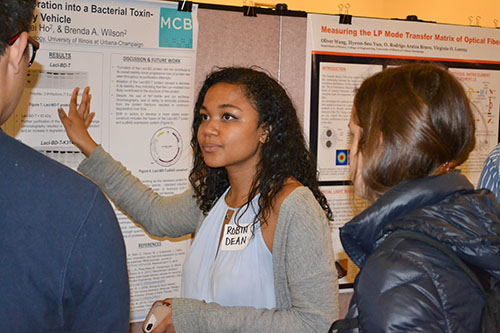 Illinois undergrad Robin Dean explains her research about a Bacterial Toxin-Based Drug Delievery System.
Illinois undergrad Robin Dean explains her research about a Bacterial Toxin-Based Drug Delievery System.To broaden this somewhat limited paradigm, Karen Rodriguez'G, the Interim Director of the university’s Office of Undergraduate Research, has coined the term, “creative inquiry.” She and her staff, who grapple with this question on a daily basis, have been working over the last several years to not just broaden the definition but to expand the opportunities, so not just students in STEM areas or the humanities but other areas, like the arts, have a chance to do research or capstone projects.
“It’s a question for us when we’re rewarding research programs, because how we evaluate them is going to be different and should be different than someone even in the humanities, which can still be a very science-oriented idea,” she admits. So to gain a broader perspective, they’ve approached faculty from, say, dance or drama, in regards to what creative inquiry might look like in some of these disciplines.
In fact, the idea for Undergraduate Research Week actually came out of what OUR staff perceived as a need to open it up so more disciplines beyond the STEM disciplines could become involved.
According to Rodriguez'G, the Undergraduate Research Symposium itself wasn’t often a useful venue for some disciplines, such as dance and music performance. So she and her staff began asking themselves, “What can we do to support and publicize the kinds of research students are doing that isn’t always going to show up at the Symposium?” So they came up with a week-long celebration of undergraduate research on campus, which would include other events in addition to the Undergraduate Research Symposium, such as the Political Science Honors Symposium, and provide a way for disciplines, such as Architecture, to exhibit students’ capstone projects—things that would be difficult to do at the Symposium. In addition, holding events featuring departments or programs would also provide a ready audience.
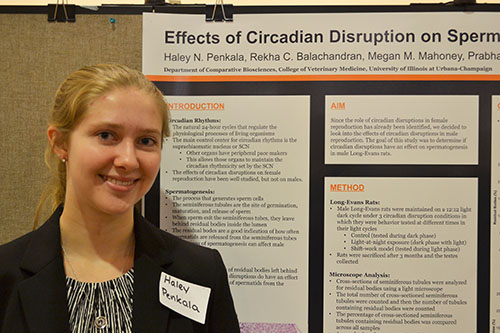 During the 2018 Undergrduate Research Symposium, Illiois undergrad Haley Penkala presents her reserch on the Effects of Circadian Disruption.
During the 2018 Undergrduate Research Symposium, Illiois undergrad Haley Penkala presents her reserch on the Effects of Circadian Disruption.
While some units already had capstone events and just switched them to Undergraduate Research Week to bring them under its umbrella, others were new events departments or units created specifically for Research Week to feature their programs, such as some of Fine and Applied Arts’ events. Rodriguez'G reports that throughout the 4-year history of the Research Week, some units have been involved every year, while others have participated sporadically.
The crown jewel of the Week, of course, is the Undergraduate Research Symposium. In its 11th year, the Symposium was begun in 2008 and has grown from 125 students the first year, to 250 students when the Undergraduate Research Office was created four years ago, to 800 students all total, with 400+ students presenting posters and the rest doing other types of presentations.
“Every student who has actually done research, we’ll give them a place at the symposium,” Rodriguez'G says. To ensure that the projects are actually research, students must submit abstracts, which her team checks to make sure it's research.
Besides posters, students also give oral presentations. In fact, Rodriguez'G and her staff believe it’s important that students be able to present to a general audience. “It’s easy to present in your field,” she says. She then goes on to describes a scenario where a student is “talking about something that’s super technical, but has a judge or a member of the audience who’s sitting there going, ‘What are you talking about?’”
To prevent this, she and her staff provide a number of workshops on both poster and oral presentation to help the students think about “How do you tell your story? (whether it’s visual media or an oral presentation), or “How do you create a poster that is interesting and esthetically pleasing, for instance, so there’s a balance of things and it’s not so text heavy?”
While she acknowledges that the Symposium is not a national conference and is a bit more low key, “It’s still a professional conference,” she indicates, explaining that students are “going to be acting as scholars, talking about their research. So I think, really, that’s what the Undergraduate Research Week and Symposium mean, is that it’s not just about students doing research, they actually need the whole range about what it means to be a scholar.”
One aspect of the whole range to which Rodriguez'G is referring this: “The research process includes presentation. That’s something you need to learn how to do!”
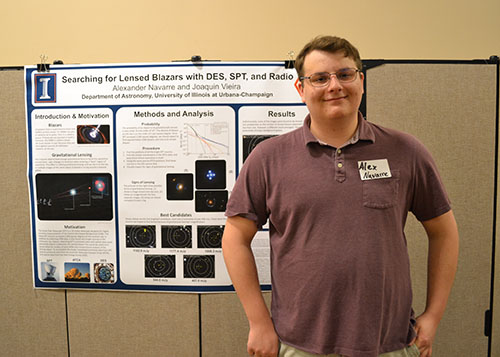 Alex Navarre with his poster about Lensed Blazars (image courtesy of Kristina Allen).
Alex Navarre with his poster about Lensed Blazars (image courtesy of Kristina Allen). One of the around 400 undergraduates who both learned about the research process, did a research project, and got to practice presenting via a poster was Alex Navarre, a senior in physics who has also worked closely with the astronomy department. Navarre started doing research his sophomore year and has been involved for the last two years. His research looked for gravitationally-lensed blazars in space to study how the earliest galaxies in the universe formed.
Navarre says he’s learned a great deal through his research: “Everything from coding abilities and new coding languages, to how the professional scientific community works, to how I’m supposed to give talks, to what is expected of me in grad school, to how to build things with carbon fiber. I could go on!”
Of course, he’s also learned a lot about early galaxies: “I think it’s really cool that I can talk about all of these things, like super-massive galaxies and things that are far back in time, and be like ‘Yeah, I know about that.’”
Navarre plans to continue doing research in the future and has been accepted into grad school at the University of Cincinnati where he will be doing data analysis for an astrophysics telescope called BICEP.
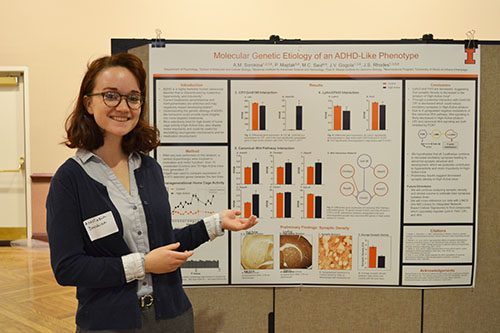 Anastasia Sorokina presents her research during the Undergraduate Research Symposium (image courtesy of Kristina Allen).
Anastasia Sorokina presents her research during the Undergraduate Research Symposium (image courtesy of Kristina Allen). Another student who presented her poster at the Symposiuim was Anastasia Sorokina, whose research looked at the genetic etiology of ADHD-linked behavior in a mouse model. Her preliminary results showed that ADHD-linked mice have decreased synaptic density. Sorokina says she picked this topic because she’s “really interested in neuroscience and specifically behavioral neuroscience.” Because she’s coming from an MCB background, she admits wanting to “incorporate the stuff I learned in MCB regarding genetics into a question that is broadly associated with behavior, like ADHD.”
Undergrad Cora Low reports getting involved in her research through the Ethnography of the University Initiative (EUI), which promotes student research about universities and colleges as complex institutions. Initially for a class, the research topic she picked looked at how international students integrate socially on the university campus. “Basically, I found five ways that they can do it,” she reports. “The most effective way was through the classroom, where they make friends with their classmates then hang out outside of class.”
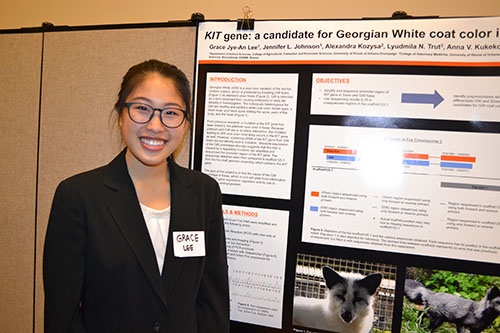 Grace Lee with her poster about the Kit gene's impact on the Georgian White Fox.
Grace Lee with her poster about the Kit gene's impact on the Georgian White Fox.One student who learned a lot about genetic sequencing through her research topic, but also learned that she didn’t want to do research as a career, was Grace Lee, a senior in Animal Sciences. For Lee, it was not only her first time presenting at the Symposium, but her first time doing research. Lee’s research investigated the cause of the Georgian white coat color in red foxes through genetic sequencing. She reports that she learned a lot.
“Previously, I didn’t have any experience in genetics, or I had no idea how to sequence things,” she explains. “So they threw me into the lab and taught me how to do it and led me along the way until I was able to push myself forward and go in my own direction and do things myself. So I got to learn a bunch of new techniques, like sequencing.”
Lee believes her research opportunity was a great way to learn outside of class and to apply what she learned in class.
“This is why I do better and better in classes,” she reports. “I apply what I learn in my research to classwork. The research helps stick the information in your brain. If you’re just learning out of your textbook, yeah, you’re learning it, but when you apply it, you remember more ways to learn, and it’s better.”
Lee says her career goals are still up in the air right now. “I’m planning to take a gap year to figure it out. But definitely still a science route, because I still have a big passion for science.”
Another important thing she learned through the experience was that she doesn’t necessarily want do research. “Not that I don’t love it,” she admits, “but it’s just because I have a different future envisioned for what I want to do.”
It wasn’t just the undergrads who found undergrad research to be rewarding. According to Rodriguez'G, one of the most rewarding things about the program is watching students grow, “Watching them go from, ‘Oh, my God! What is this?’ to ‘I’m so excited!’”
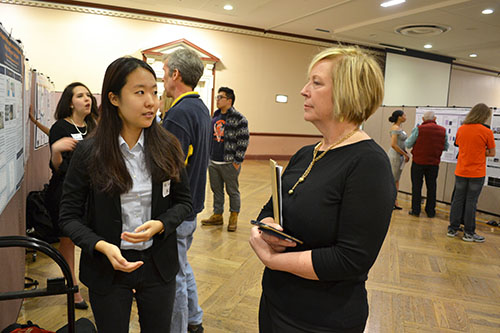 Karen Rodriguez'G, Interim Director of the Office of Undergraduate Research (center, foreground), listens as an Illinois undergrad presents her research durng the Undergraduate Research Symposium.
Karen Rodriguez'G, Interim Director of the Office of Undergraduate Research (center, foreground), listens as an Illinois undergrad presents her research durng the Undergraduate Research Symposium.She admits that early on, “Most of them were very overwhelmed by this idea of presenting at the Symposium and developing a research project. One of the things I’ve seen this last week as they were preparing to present at the Symposium, is the fact that they’re actually seeing it come together, and they’re so excited and proud of themselves!”
She reports that, looking back to the beginning of the semester, “It all seemed so overwhelming, and they had no idea what to expect. And now, they see themselves as researchers in a very real way,” she claims. “And that seemed like a very far-off thing for them at the beginning of the semester.”
Adds Rodriguez'G, “For me, that’s one of the things that I find so fulfilling, is watching them grow, seeing what they’re doing, helping them along the way.”
Story and photographs by Elizabeth Innes, Communications Specialist, I-STEM Education Initiative.
More: Engineering, Undergrad, Undergrad Research Symposia, 2018
For more I-STEM articles about Illinois undergraduate research, see:
- ISUR Poster Expo Showcases Engineering Scholars' Research
- Engineering’s Undergraduate Research Office Encourages Undergrads to Experience Research
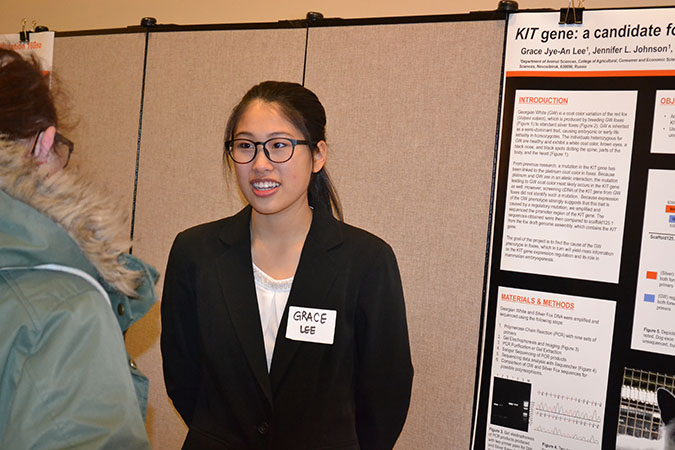 Illinois undergrad Grace Jye-An Lee presents her research about the KIT gene..
Illinois undergrad Grace Jye-An Lee presents her research about the KIT gene.. 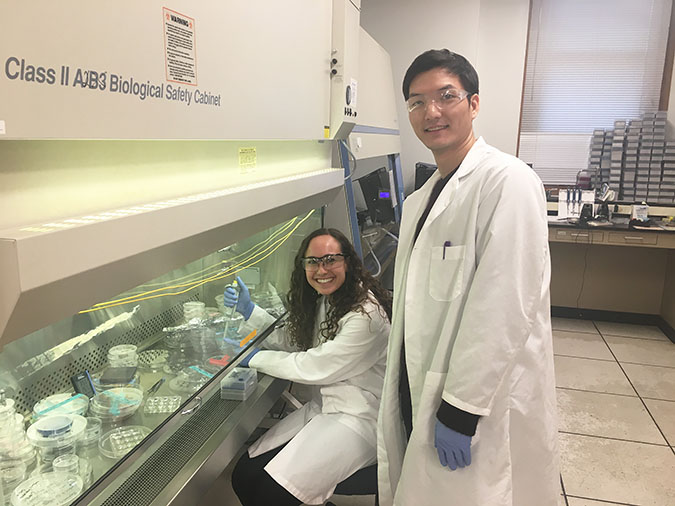 Engineering undergraduate student Nicole Juguvich and her grad student mentor, Hyunjoong (Tim) Chung, at work in Chemical Engineering Professor Ying Diao's Lab (photo courtesy of Nicole Juguvich).
Engineering undergraduate student Nicole Juguvich and her grad student mentor, Hyunjoong (Tim) Chung, at work in Chemical Engineering Professor Ying Diao's Lab (photo courtesy of Nicole Juguvich). 












.jpg)
















